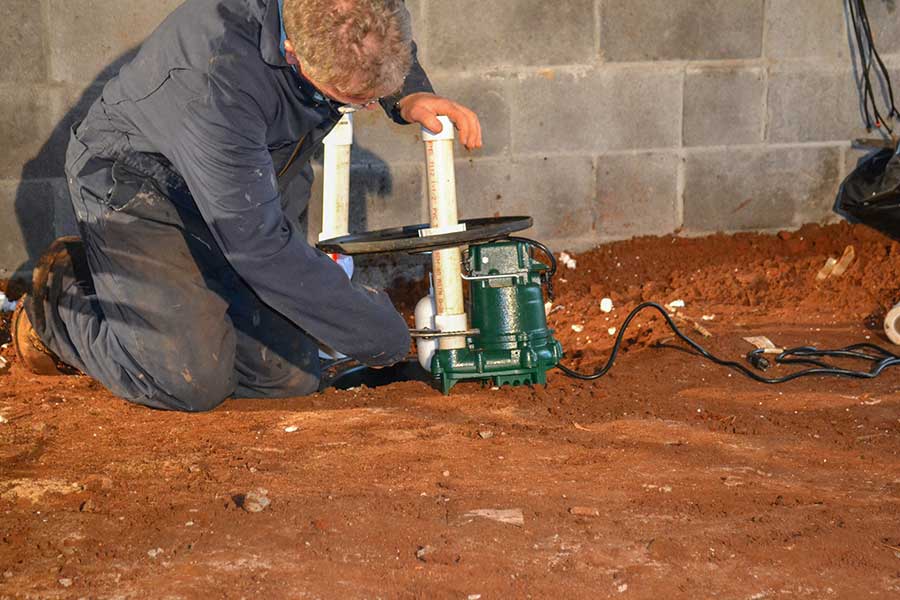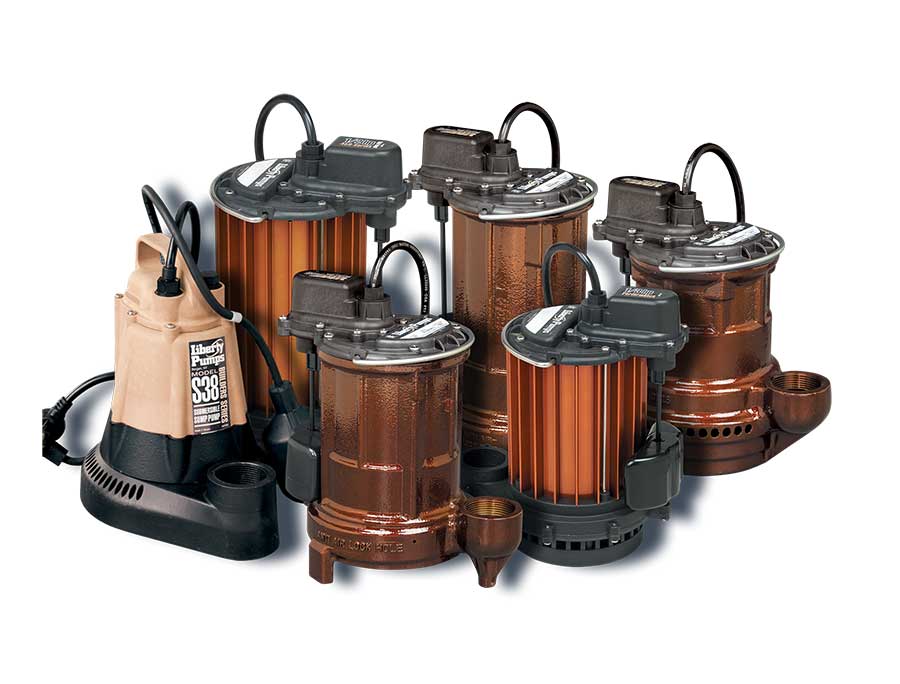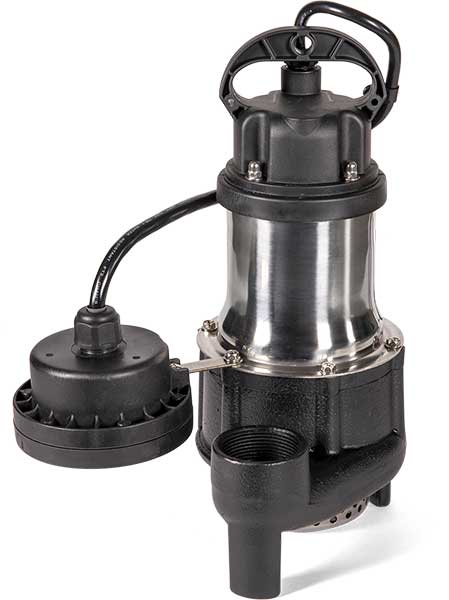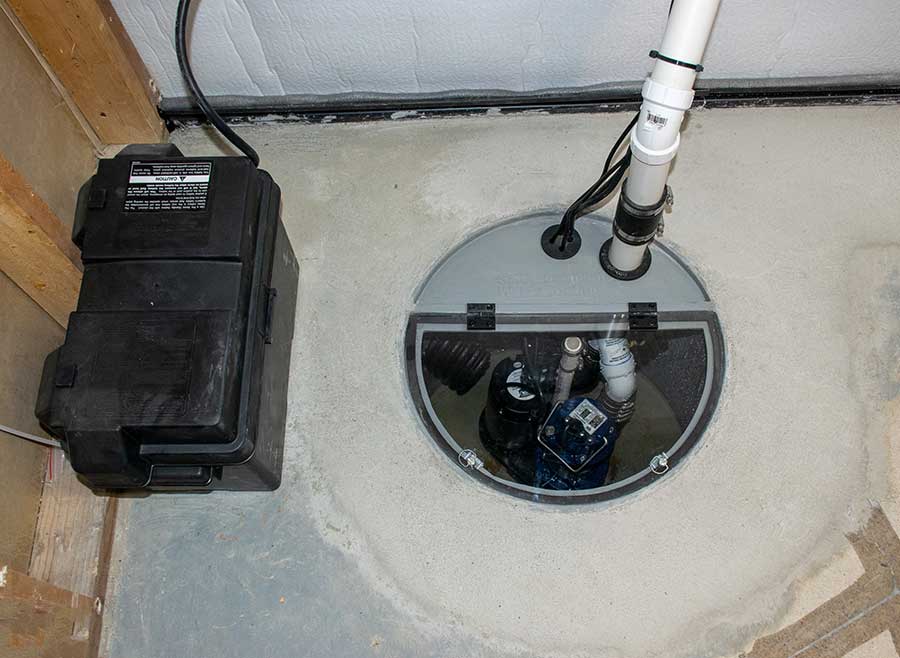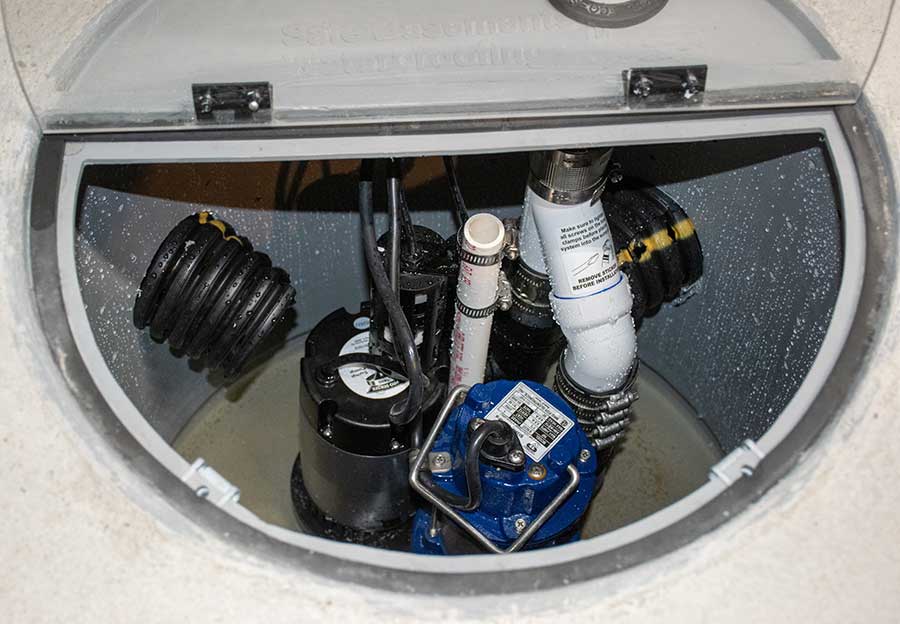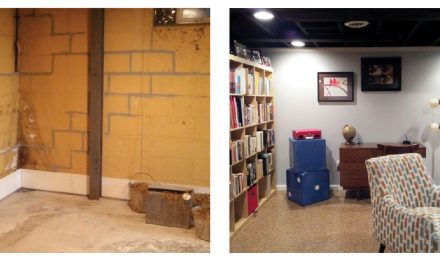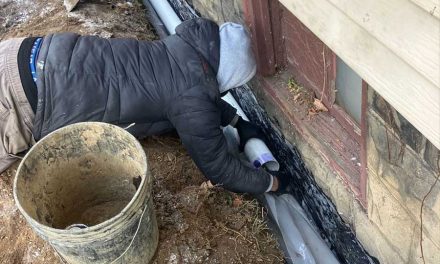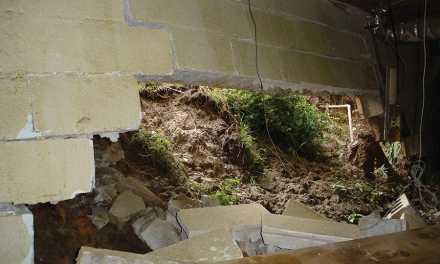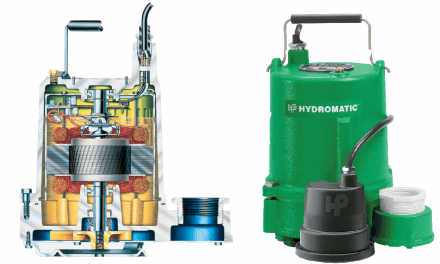By Vanessa Salvia
Photo courtesy of Crawlspace Depot
A typical installation of a submersible sump pump system in a crawl space. This system utilizes a cast-iron sump pump, basin, and check valve.
Sump pumps are an essential tool for waterproofing professionals looking to keep a basement or crawlspace dry. These pumps help remove excess water from a space, preventing damage to the foundation and any stored items. But with so many options available, how do you choose the right sump pump for your needs?
“If you have a situation where you have water infiltration in either a basement or a crawl space, in most cases, we would be installing an interior drain system, and then tying it to a basin and a sump pump that is within the basin to then extract the water and take it somewhere else,” says Billy Tesh, president of Crawlspace Depot.
What Is A Sump Pump?
First of all, let’s talk about the name, “sump pump.” Sometimes people will say “sub pump,” either out of confusion because they have mis-heard someone say “sump,” or because they think the word is “sub” because these pumps are often placed underneath houses. The word “sump” means pit. Sump pumps are usually placed in a basement or crawl space of a home, so they are “sub,” meaning “underneath,” the house. There are also pumps that are used in the yard to move away standing water. In that case, it is typically called a transfer pump, but it works in the same way.
Sump pumps are used to move standing water, to keep basement or crawl space flooding at bay, to prevent breeding grounds for mosquitoes by clearing the water, and controlling mold and mildew growth.
Types of Sump Pumps
There are two main types of sump pumps: submersible and pedestal. Both types of pumps have their pros and cons, and the type you choose will depend on your specific needs.
“As the name suggests, a submersible pump is designed to be submerged in water without damaging the motor or any components,” says Jeff Goodenbery, customer service manager for Liberty Pumps in New York. “A pedestal pump is installed in a sump pit with only the bottom in the water. A column connects the wet end to the motor. The pedestal pump motor is not waterproof, and is always kept out of the water.”
Submersible Sump Pumps
Submersible sump pumps are the more popular choice for homeowners and waterproofing professionals alike. These pumps are designed to be placed inside the sump pit and can be completely submerged in water. Because they are submerged, they operate more quietly than pedestal pumps and are less visible, making them a popular choice for finished basements.
Submersible pumps are also more efficient than pedestal pumps. Because they are closer to the water source, they don’t need as much energy to move the water out of the space. They are also less likely to overheat and burn out because they are cooled by the water surrounding them.
Pedestal Sump Pumps
Pedestal sump pumps are an older design and are bigger and bulkier. These are not as popular as they once were. These pumps are designed with the impeller and pump housing in the water and a motor shaft and switch rod that penetrates through the cover. Because they are not submerged, they are more visible and can be noisier than submersible pumps.
One advantage of pedestal pumps is that they are easier to service and repair than submersible pumps. Because they are not submerged, they can be easily accessed without having to remove them from the pit. They are also less expensive than submersible pumps, making them a good choice for homeowners on a budget.
Brian Drafke, Ion Technologies/Metropolitan Industries wholesale sales manager, says the company does not use pedestal pumps at all. In Illinois, where Ion/Metro operates, the pits must be completely sealed because of radon. “Because the pedestal pump and float switch have to be mounted through the cover of a sump pump basin, it’s not completely sealed then, because the rod has to be able to float up and down,” Drafke explains. There are other territories throughout the United States where there are similar mandates about dealing with radon.
Goodenberry says that a pedestal pump is normally a less expensive option and they can also be placed in narrower sump pits. “But a pedestal pump cannot be used in outdoor applications, and because the motor is not protected, an exceptionally damp basement could cause the motor to prematurely fail,” he says.
Goodenberry also goes on to explain that submersible pumps tend to overheat less because the motor is surrounded by water instead of air. This also means that a pedestal pump is easier to maintain and repair. “With a pedestal pump, the motor is easily accessible, and less parts of the pump in the water could mean less damage from hard ground water,” he says.
Tesh says that Crawlspace Depot also only carries high-quality submersible brands. “These pumps need to be dependable,” Tesh says. “The pedestal pumps are taller, longer. They tend to be noisier. And more importantly, they’re just not as compact for use in a crawl space area. For instance, if you had a crawl space that was two feet tall, it would be cumbersome. And then you’d have this motor sticking out of the sump well itself.”
Choosing the Right Sump Pump
When choosing a sump pump, there are several factors to consider, including:
- the size of the space that needs to be cleared
- square footage of drainage that needs to be removed
- the available power source
- 1- or 2-pump systems, with or without battery backups
- energy consumption (amp draw)
- flow rate (GPM)
- the location of the pit
- Size of the Space
The size of the space will play a role in determining the size of the sump pump you need. If you have a large basement or crawl space, you will need a larger pump to remove the water efficiently. If you have a small space, a smaller pump may be sufficient.
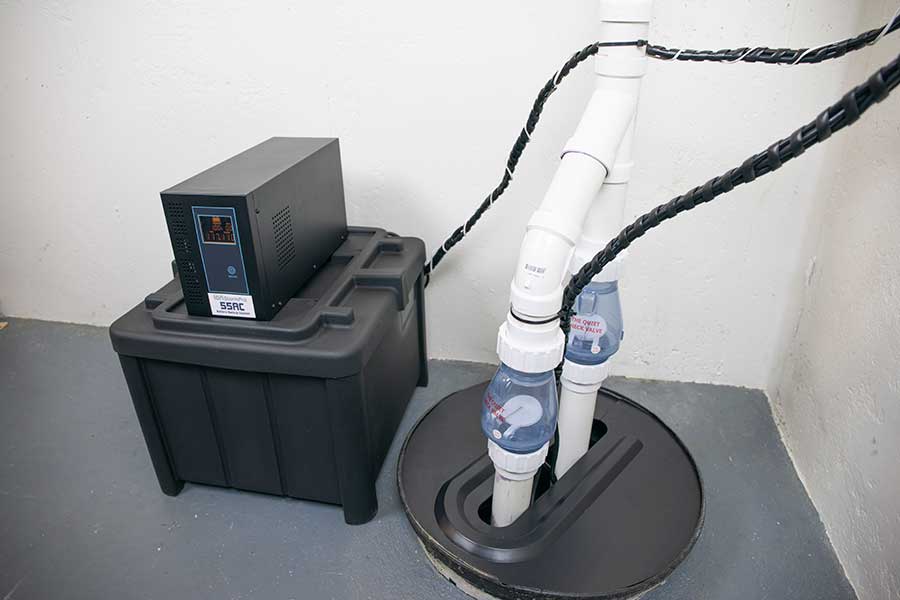
A finished installation of a 55ACi Deluxe model by Metropolitan Industries. (Photo courtesy of Metropolitan Industries)
“The amount of space in your basement can affect your decision,” on which pump to choose, explains Goodenberry. “A submersible pump is located completely within the sump, but a pedestal pump will take up space above the sump as well.”
Amount of Drainage
The amount of water that needs to be removed will also play a role in determining the size of the pump. If you have a lot of water entering your space, you will need a larger pump with a higher capacity. If you only have occasional leaks or minor water issues, a smaller pump may be sufficient.
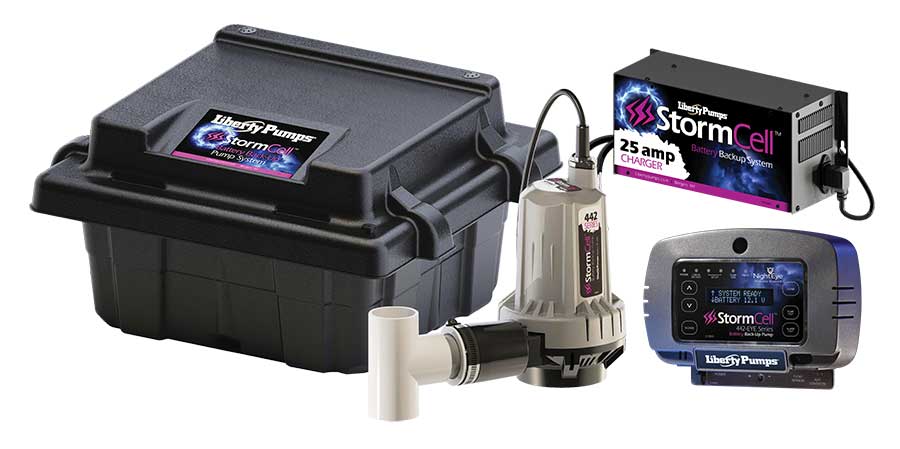
Liberty Pumps Model 442 battery backup pump with NightEye technology. (Photo courtesy of Liberty Pumps)
“The amount of water that needs to be pumped is greatly dependent on the square footage of the building and the area that you live in,” says Goodenberry. “A 1/3-horsepower sump pump is very common, but this might not be enough for a large building or a very wet area. Also keep in mind the distances that the water needs to be pumped. The greater the distances, the less flow you will get out of the pump. If there are questions, it might be best to seek the knowledge of waterproofing experts or the pump manufacturers, who can help to size a pump for your application.”
Power Source
Sump pumps can be powered by electricity or by a battery backup system. A battery backup system and monitoring is a must-have, even if you live in an area that doesn’t experience power outages. This will ensure that your pump continues to work even if the power does go out. A monitoring system will give you critical alerts in the event that you are on vacation, for instance.
1- or 2-pump Systems, Battery Backups
Ion Technologies/Metropolitan Industries manufactures their own brand of sump pumps. Drafke says that Ion/Metro prefers to install 2-pump systems with an inverter battery backup. “An all-in-one 2-pump system with a battery backup is what we prefer to put in every house as opposed to just a battery backup, because if one pump fails the other one just automatically starts and if the power goes out the pumps still work due to their battery backup inverter,” he says.
Metro also manufactures a product called the Ion Connect. The Connect is a sump pump controller monitoring/alarm to notify the homeowner of any issues that may arise with their system using a phone app as the interface. Users can remotely find out whatever might be going on in the basement or crawl space — which are typically environments that people don’t enter very often.
“You plug the pumps into the Ion Connect and it monitors everything,” says Drafke. “It tells you if you have high-water levels or power outages. It also tells you if the pumps switch and/or a pump is not working when it needs to be. Emergency alerts are sent via text or push notifications on the Ion Connect App.”
Patrick Nevison, an engineer with Safe Basements, says that the sump baskets used by SafeBasements have a polycarbonate cover allowing for easy monitoring of the sump pit and is strong enough to stand on. “Safe Basements supplies Pro-Series Pumps which have control boxes with lights and alarms to notify the homeowner of issues with the pump, such as power outages, or pump failures,” Nevison says. “Wi-Fi devices are also available, to make notifications to homeowners who may be out of town. It is best to check on the sump pit on a regular basis and ensure the floats are free of debris.”
Energy Consumption & Flow Rate (GPM)
There are two key terms when talking about pumps: GPM and TDH (total dynamic head) or Head for short. The relationship between Head height and GPM determines the performance requirements of your pump. Gallons per minute, or GPM, refers to how much water a pump will move. Pumps have measurements of “GPM at X feet of Head.” The term Head is related to how high the water can be pushed through the system. Flow rate is measured in GPM, and should be 30 to 35 GPM at a minimum at 10 to 15 feet of Head.
“For every foot that you go up above the waterline, or whatever the point that you put the sump pump at, you lose capacity in pumping,” Tesh explains. “A gallon of water weighs 8.34 pounds, so you’re having to push every gallon of that water up that stack value. You can check a chart that lists out ‘this pump with this head will pump this many gallons.’ That’s part of what you need to figure out so you know if you need a larger pump. If you’ve got a large volume of water that you’re dealing with in residential, usually that’s not a big issue. But in a commercial building, you might have some concerns there.”
Drafke says that most competitor standard 1/3-hp pumps pump 30 to 40 GPM and Ion/Metro’s 1/3-hp pumps, the WC33I or the BA33I, pump 42 to 55 GPM. “The real difference between them besides GPM is the amp draw,” says Drafke. “Most competitor 1/3-hp pumps draw 6 to 9 amps but Ion 1/3-hp pumps draw only 4.5 to 5.5,” he says. “Why does that matter with a sump pump?
The lower the amp draw, the longer the run time on a battery backup because we’re not using that much energy.”
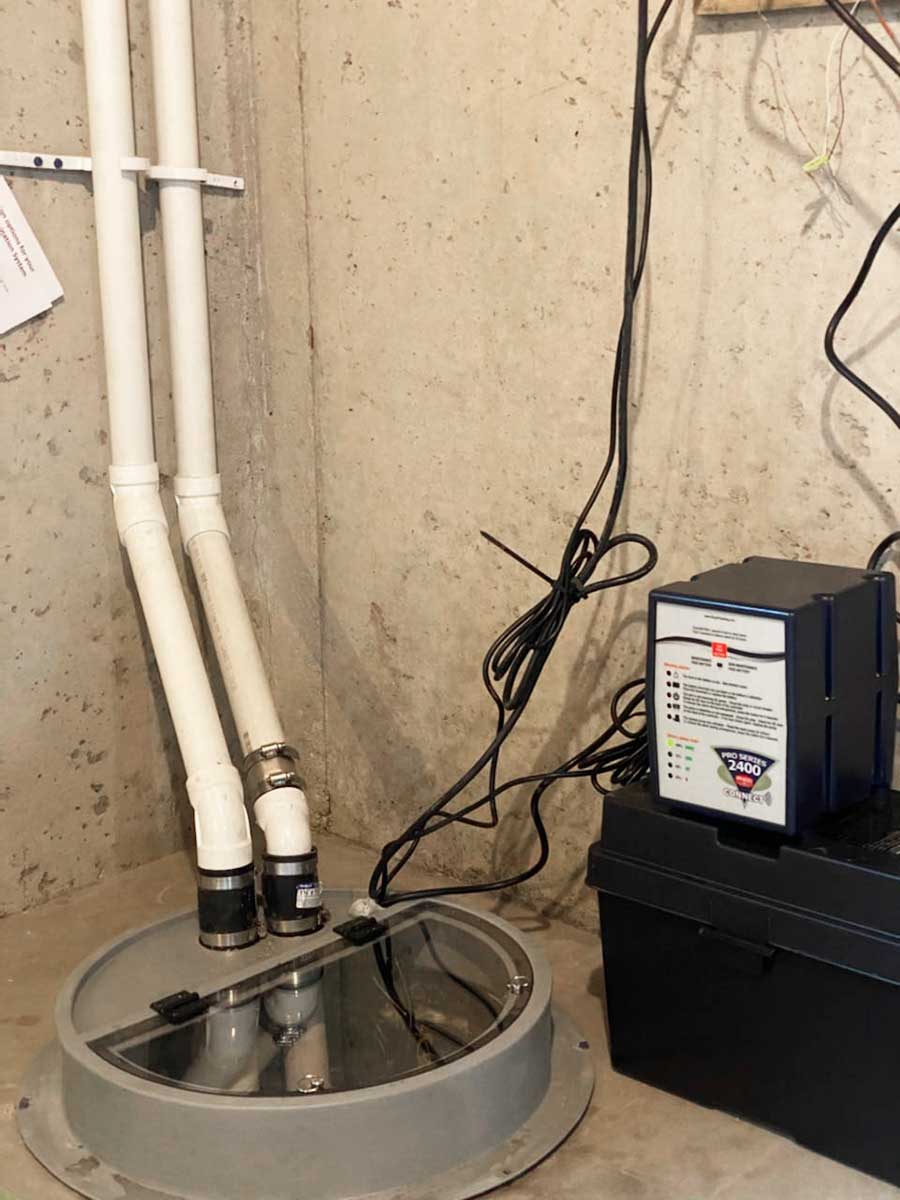
SafeBasements’ standard sump basket with polycarbonate lid. Installed is a Pro-Series PS-C33 Combination Pump,
including primary and battery backup. The control box will relay messages to the homeowner regarding the functionality of the pump system. The sump basket is connected to the interior drain tile system. (Photos courtesy of Safe Basements)
Location of the Pit
Choose a low-lying area: The purpose of a sump pump is to remove water that has accumulated in a sump pit, which is typically located in a low-lying area of your basement or crawl space. The pump should be installed in the lowest point of the sump pit so that water can flow into it naturally. Typically, the sump pump is installed when the home is being built, so the homeowner probably doesn’t have any say in that.
Avoid areas prone to debris: When choosing the location for your sump pump, avoid areas that are prone to debris such as leaves, dirt, or gravel. Debris can clog the pump and cause it to malfunction.
Ensure easy access: The sump pump should be installed in an area that is easily accessible for maintenance and repair. Avoid installing it in a hard-to-reach area that may require special tools or equipment to access.
Keep it away from electrical appliances: The sump pump should be installed on its own dedicated circuit and separate from electrical appliances. This is to prevent overload on the pump’s electrical breaker in case of an appliance electrical malfunction.
Ensure proper drainage: The sump pump should be installed in an area with proper drainage. If the water cannot flow away from the pump, it can cause damage to the pump and your property.
Connection to interior drainage: “The sump pump will need to be in a location that is connected to the interior drain tile system,” says Nevison. “This is typically along the perimeter of the basement or crawlspace. A sump basket that is not connected to the drain tile will only have a limited area of effect on the basement. It is best to have the pump near an area where the discharge can be run outside and have the water flow away from the home.”
Nevison explains that the sump basket collects water from the drain tile system and the pump discharges the water outside of the home. The discharge location needs to be an area that will allow the water to run away from the home, so that it is not recycled into the system. “If an area has severe water issues, or the basement is very large, multiple sump baskets may be needed, each with their own pumps and discharges,” he says.
The Bottom Line
In summary, the right location for your sump pump is in a low-lying area that is easily accessible, away from debris, electrical appliances, and outlets, and with proper drainage. By taking these factors into consideration, you can ensure that your sump pump is installed in a safe and effective location that will protect your home from flooding and water damage.

Vanessa Salvia
Editorial Director
Vanessa Salvia Writer, Editor, Content Creator Writer - Editor - Content Creator Over a nearly 20-year career as a journalist, I have learned the importance of telling stories and delivering a clear message. As a content creator, I help businesses build their brands and communicate their messages in the most effective ways.
Summer 2023 Back Issue
$4.95 – $5.95
Asbestos in the Waterproofing Industry
Choosing and Installing Sump Pumps
Cool Roofing
Case Study: Interior Basement Waterproofing
Description
Description
Asbestos in the Waterproofing Industry
By Gregory Fahrenbruch
Asbestos is a scary word for a homeowner to hear because of its reputation for causing harmful lung conditions. Asbestos does exist in homes that waterproofers work on, though, so the waterproofing industry cannot overlook this substance.
Choosing and Installing Sump Pumps
By Vanessa Salvia
Sump pumps are an essential tool for waterproofing professionals looking to keep a basement or crawlspace dry. These pumps help remove excess water from a space, preventing damage to the foundation and any stored items.
But with so many options available, how do you choose the right sump pump for your needs?
Cool Roofing
By Vanessa Salvia
Cool roofs keep interior spaces cooler, which lowers energy costs, keeps buildings and homes more comfortable, and can reduce carbon emissions.
Case Study: Interior Basement Waterproofing
By ’58 Foundations & Waterproofing
In a Pennsylvania home, a homeowner with a basement was plagued by problems with invasive water. The sump pump was failing whenever the water table got high, and the basement was getting wet as a result.
Additional Info
Additional information
| Weight | N/A |
|---|---|
| Magazine Format | Digital Download Magazine, Print Mailed Magazine |

